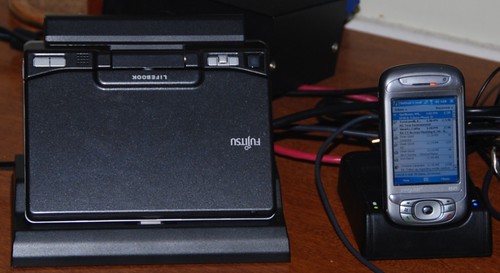Outsourcing is sometimes viewed as a dirty word in organizations, and the Information Technology (IT) department is right there with that sentiment. C level executives looking to improve the organization’s bottom line by outsourcing non-core areas create anxiety among employees who become fearful of losing their jobs.
Traditional OutsourcingThe general thought behind outsourcing is to look for the areas in an organization that are not critical to products or services that drive the viability of the organization. Any function that is not directly related to why a customer may buy from you is reviewed for potential outsourcing. This is based on the assumption that an organization that focuses on a function will do it better than one that does not. I work in an IT consulting firm; we provide services by way of having talented individuals working as a team to provide services to clients. We cannot outsource that function, because they are the way we can show a profit, and the reason people would view us favorably (based on past successful work using the same team, tools, and methodology).
But we don’t clean our office.Not that it is dirty, but that function is not core to the services we provide. We contract with somebody to come in daily and clean. They do it efficiently and to our satisfaction while showing a reasonable profit. We cannot do that by using our higher paid employee base; it would make no sense. We outsource that non-critical function to somebody who views it as a critical function.
We may not have as many employees because of this, but the ones we have share our focus of IT services. If we used to have our own cleaning staff, the desire to outsource would have cause significant stress for them, and been a paradigm change for us.
Therein lies the reason outsourcing is sometimes a dirty word.
Some organizations view IT the same way we view cleaning; as a non-core function that can be outsourced. Large companies such as IBM, Perot Systems, and Hewlett-Packard make significant revenue from providing outsourced services. We make a reasonable profit in certain clients from providing outsourced services. If your organization manufactures widgets; then maybe the IT function is not core, right along with cleaning, payroll, tax accounting, and even sales, among others. None of these need to be provided by somebody working exclusively at your direction, and for your singular purpose.
Everything I have alluded to implies outsourcing applies to people – reduce the headcount managed in a function by finding somebody else to perform the service, and even manage it. This can result in the employee leaving work on Friday working for company “A”, and returning on Monday to the same cubicle but employed by company “B”, possibly with reduced benefits, career opportunities, etc. Company “A” saves capital, and can focus on core functions. This has been the outsourcing method used popularly for the last 20 years or more.
New Technologies Change the TermsBut new technologies change the terms of outsourcing: instead of focusing on the headcount of people, focus on the specific function. These technologies are known as Service Oriented Architecture (SOA), and are made possible by using the internet as a transport layer between systems that are made available to provide services (known as “Web Services”) to each other. While these technologies cannot help us clean our office (that is after all a physical function) they can help us in many other areas, and any business process provided by application or even system software can be reviewed for outsourcing. This capability was not available before technologies like the web and web services.
Service Oriented Architecture (SOA) is a model that ties disparate systems together using communication interfaces that allow them to talk to each other in industry standard terms. You might consider it an evolution of long established Electronic Data Interface (EDI). But EDI, while still providing value in many functions, has two inherent problems. First of all, it is focused on the format of the messages, not the means of actually transporting them. Because of this, so called Value Added Networks grew to provide connection services and clearing houses between two systems that could not natively talk to each other. This increases costs, and reduces flexibility. Secondly they only cover specific transactions that a standards board has set. So you can transport a Purchase Order and an invoice, but not a flight reservation, request for properly formatted +4 zip codes, or product specification; some things that various organizations would be very interested in. So EDI has a standard, but it is limited to specific functions and specific data elements within those functions. This in turn limits an organization from responding to their own needs.
What SOA provides is the ability of two organizations to agree to outsource a function, but not necessarily a person, as has been the approach to outsourcing. We are not implying that no employment will be lost, but are viewing future outsourcing as being service or function based, as opposed to being team and job based. The employee headcount may be reduced or held steady as a side effect, but the focus is finding some web service that can process information and return it to us better than we can ourselves.
Business Process Engineering and SOABusinesses have spent a lot of time thinking about the process they used, and they have defined and redefined it using Business Process Reengineering, Six Sigma, Total Quality Management, Continuous Improvement, etc. ad nauseam. Many improvements were made, and that unique business process, designed for the organization that employs it, has been encapsulated in the organization that uses it. It is hidden in business rules and databases, web pages and email clients, ready to be forced on users at the appropriate time to make sure the business process is followed. This gives rise to ERP systems, and large Line of Business applications (LOB) that perform functions across an enterprise, following a predefined business process to ensure uniformity, predictability, and cohesion among business functions. Take for example the simple Zip Code + 4 function: an organization wants to ensure that every mailing is successfully delivered to the right location, and so as part of the process they run the address against a computer application that returns the correct nine digit zip code. In this way, costs are reduced, and the correct targets receive the content in the mailing. But sometimes the rules or even underlying data change in this specific function. New addresses are added, street names changes, zip codes redefined, etc. This may necessitate a change deep within the LOB or ERP, and your organization, with its very organizational specific business process built into the system, is the only one capable of making the change using internal employees familiar with the code and structure. You bear the full cost of the change, and can only amortize it across your organization. But the Zip Code + 4 function is NOT core to the business. It needs to be done, but it is not how you actually generate revenue. The content of the mailing should do that, but the commonly used Zip Code + 4 does not.
The architecture organizations have traditionally used over this re-engineering period is monolithic. They built single system, or tightly integrated systems, that they owned or highly customized to the point of not even looking like the application they procured. These were often hidden behind a firewall, focused on the broad and internal needs of the organization’s process. What they did not invite was the ability to simply integrate one little external function into the business process. So the Zip Code + 4 function remains locked in the LOB or ERP. This limits flexibility to reuse and share the function, expand it to new acquisitions; in short to generally focus on the core process.
But what if you found another organization, that focuses only on this functional need, and which would allow you to connect your business process directly to theirs? You send them the address, and they send you back the properly formatted address with the correct Zip Code + 4? That is what SOA and web services can provide. You can pick from various vendors who will provide the service, selecting the one that best meets your quality and budgetary needs.
SummaryThis provides in the end an outsourcing model that looks at specific functions within a business process, instead of specific departments or personnel. You may reduce headcount, and in fact likely will, but that was not the focus. The focus was on improving quality and flexibility, and at the same time turning your attention to the core functions and systems that encapsulate enforces those functions.
This may be the future of outsourcing as a part of the process of reviewing for opportunities to do so. I invite your thoughts on the subject.
 t like I wrote on paper. In fact it can even have a notebook like template in products like Microsoft OneNote. I can write in various colors and ink, thickness, use a highlighter, draw pictures, etc.; anything I can do on paper. But the disadvantage is that my handwriting is not very good, so people prefer I give them a typed document. The amazing thing is that the ink recognizer, which looks at what I wrote in my sloppy handwriting, and converts it to typed text, is better at identifying the characters than most people are, including myself. Sometimes when I cannot figure out what I wrote, I run the converter and it tells me. I could explain how it does that, but that is for another day.
t like I wrote on paper. In fact it can even have a notebook like template in products like Microsoft OneNote. I can write in various colors and ink, thickness, use a highlighter, draw pictures, etc.; anything I can do on paper. But the disadvantage is that my handwriting is not very good, so people prefer I give them a typed document. The amazing thing is that the ink recognizer, which looks at what I wrote in my sloppy handwriting, and converts it to typed text, is better at identifying the characters than most people are, including myself. Sometimes when I cannot figure out what I wrote, I run the converter and it tells me. I could explain how it does that, but that is for another day.




